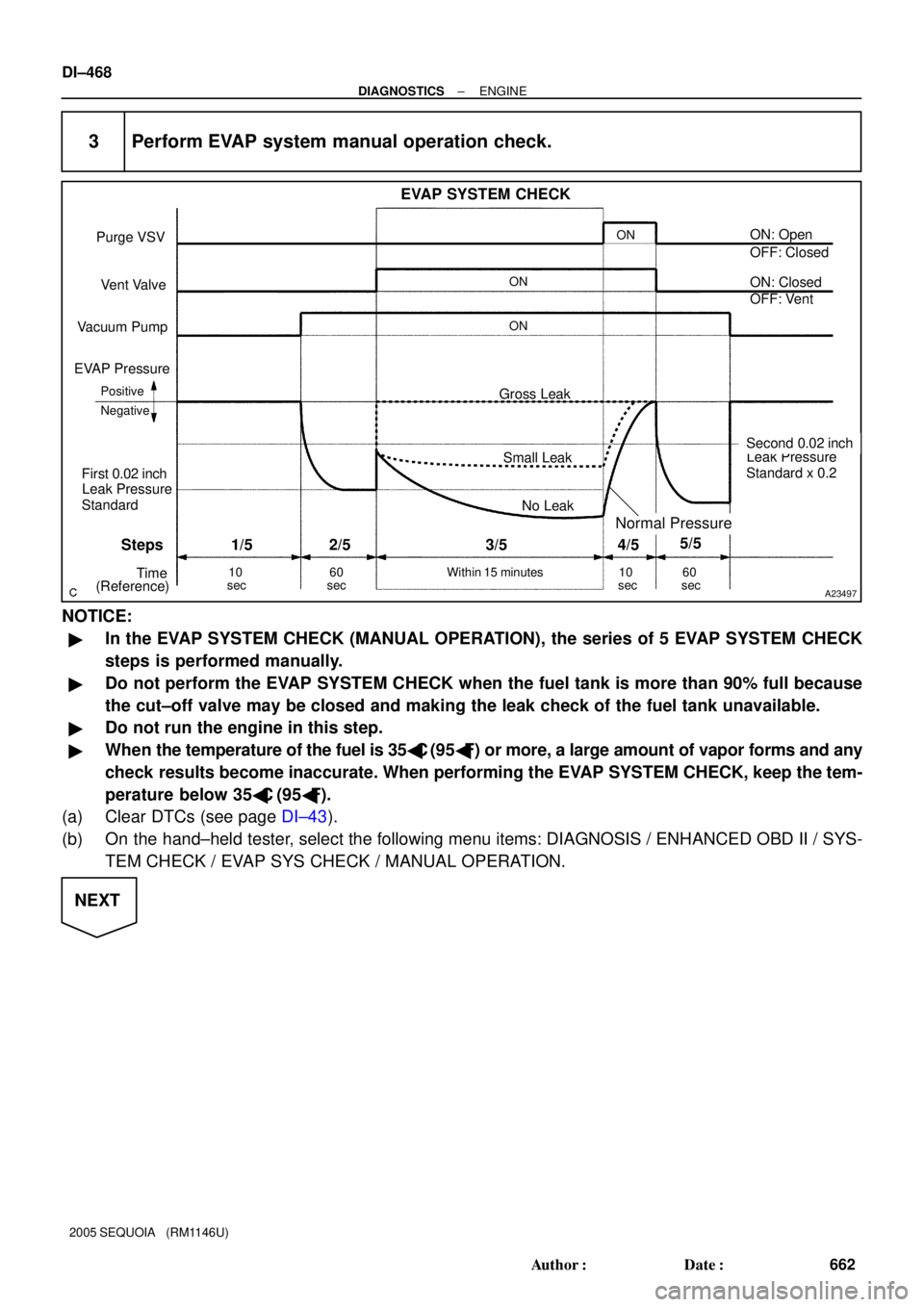Page 658 of 4323

B17396
HT +B
AF± AF+ Sensor 1A/F Sensor Component Side:
Front View
DI±456
± DIAGNOSTICSENGINE
650 Author�: Date�:
2005 SEQUOIA (RM1146U)
1 Check any other DTCs output (in addition to DTC P2A00 or P2A03).
PREPARATION:
(a) Connect a hand±held tester to the DLC3.
(b) Turn the ignition switch to ON and turn the tester ON.
(c) Select the following menu items: DIAGNOSIS / ENHANCED OBD II / DTC INFO / CURRENT CODES.
CHECK:
(a) Read DTCs.
Result:
Display (DTC Output)Proceed To
P2A00 and/or P2A03A
P2A00 and/or P2A03 and other DTCsB
HINT:
If any DTCs other than P2A00 and/or P2A03 are output, troubleshoot those DTCs first.
B Go to DTC chart (See page DI±58).
A
2 Check resistance of air±fuel ratio (A/F) sensor heater.
PREPARATION:
Disconnect the air±fuel ratio (A/F) sensor connector.
CHECK:
Measure resistance between the terminals of the A/F sensor
connector.
OK:
Standard:
Tester ConnectionSpecified Condition
HT (1) ± +B (2)Between 1.8 W and 3.4 W at 20�C (68�F)
HT (1) ± AF± (4)10 kW or higher
NG Replace air±fuel ratio (A/F) sensor.
OK
Page 660 of 4323
DI±458
± DIAGNOSTICSENGINE
652 Author�: Date�:
2005 SEQUOIA (RM1146U)
NG Replace or replace harness or connector.
OK
4 Perform confirmation driving pattern.
NEXT
5 Check whether DTC output recurs (DTC P2A00 or P2A03)
CHECK:
(a) On the hand±held tester, select the following menu items: DIAGNOSIS / ENHANCED OBD II / DTC
INFO / PENDING CODES.
(b) Read DTCs.
RESULT:
Display (DTC Output)Proceed To
P2A00 or P2A03A
No outputB
B Check for intermittent problems
(See page DI±11).
A
6 Replace air fuel ratio sensor.
NEXT
7 Perform confirmation driving pattern.
NEXT
Page 661 of 4323
± DIAGNOSTICSENGINE
DI±459
653 Author�: Date�:
2005 SEQUOIA (RM1146U)
8 Check whether DTC output recurs (DTC P2A00 or P2A03)
CHECK:
(a) On the hand±held tester, select the following menu items: DIAGNOSIS / ENHANCED OBD II / DTC
INFO / PENDING CODES.
(b) Read DTCs.
RESULT:
Display (DTC Output)Proceed To
P2A00 or P2A03A
No outputB
A Check air±fuel ratio extremely lean or rich
(See page DI±165).
B
END
Page 668 of 4323

0.02 inch orifice clogged
Pressure sensor voltage lowP043E
P043FP0441 P0451 P0452 P0453 P0455 P0456 P2419P2401
P2402
0.02 inch orifice high±flow
Pressure sensor stuck
Pressure sensor noising
Gross leak
Small leak
Vacuum pump stuck OFF
Vacuum pump stuck ON
Vent valve stuck ON (closed)
Vent valve stuck OFF (vent) Purge VSV stuck open
Purge VSV stuck closed
Pressure sensor voltage high
DTCs
Malfunctioning AreasP2420P0450
DI±466
± DIAGNOSTICSENGINE
660 Author�: Date�:
2005 SEQUOIA (RM1146U)
INSPECTION PROCEDURE
NOTICE:
A hand±held tester is required to conduct the following diagnostic troubleshooting procedure.
HINT:
�Using hand±held tester monitor results enables the EVAP (Evaporative Emission) system to be con-
firmed.
�Read freeze frame data using a hand±held tester Freeze frame data record the engine condition when
malfunctions are detected. When troubleshooting, freeze frame data can help determine if the vehicle
was moving or stationary, if the engine was warmed up or not, if the air±fuel ratio was lean or rich, and
other data, from the time the malfunction occurred.
1 Confirm DTC.
(a) Turn the ignition switch to OFF and wait for 10 seconds.
(b) Turn the ignition switch to ON.
(c) Turn the ignition switch to OFF and wait for 10 seconds.
(d) Connect a hand±held tester to the DLC3.
(e) Turn the ignition switch to ON and turn the tester ON.
(f) Select the following menu items: DIAGNOSIS / ENHANCED OBD II / DTC INFO / CURRENT CODES.
(g) Confirm DTCs and freeze frame data.
If any EVAP system DTCs are set, the malfunctioning area can be determined using the table below.
NOTICE:
If the 0.02 inch reference pressure difference between the first and second checks is greater than
the specification, the DTCs corresponding to the reference pressure (P043E, P043F, P0441, P0455,
P0456, P2401, P2420) will be all stored.
NEXT
Page 669 of 4323

± DIAGNOSTICSENGINE
DI±467
661 Author�: Date�:
2005 SEQUOIA (RM1146U)
2 Perform EVAP system check.
NOTICE:
�In the EVAP SYSTEM CHECK (AUTO OPERATION), the series of 5 EVAP SYSTEM CHECK steps
is performed automatically. It takes a maximum of approximately 18 minutes.
�Do not perform the EVAP SYSTEM CHECK when the fuel tank is more than 90% full because
the cut±off valve may be closed and making the leak check of the fuel tank unavailable.
�Do not run the engine in this step.
�When the temperature of the fuel is 35�C (95�F) or more, a large amount of vapor forms and any
check results become inaccurate. When performing the EVAP SYSTEM CHECK, keep the tem-
perature below 35�C
(95�F).
(a) Clear DTCs (see page DI±43).
(b) On the hand±held tester, select the following menu items: DIAGNOSIS / ENHANCED OBD II / SYS-
TEM CHECK / EVAP SYS CHECK / AUTO OPERATION.
(c) After the EVAP SYSTEM CHECK is completed, check for pending DTCs by selecting the following
menu items: DIAGNOSIS / ENHANCED OBD II / DTC INFO / PENDING CODES.
HINT:
If no pending DTC is displayed, perform the Monitor Confirmation after this repair is completed. After this
confirmation, check for pending DTCs. If no DTC is displayed, the EVAP system is normal.
NEXT
Page 670 of 4323

A23497
Purge VSV
Vent Valve
Vacuum Pump
EVAP Pressure
Positive
Leak PressureON: Open
NegativeONON
Steps
(Reference)60 Within 15 minutes 10 60ON
First 0.02 inch
2/5 3/5 4/55/5
OFF: Closed
OFF: Vent ON: Closed
EVAP SYSTEM CHECK
sec sec sec
Normal Pressure
10
sec
1/5
Gross Leak
No Leak Small Leak
TimeLeak Pressure
Second 0.02 inch
StandardStandard x 0.2
DI±468
± DIAGNOSTICSENGINE
662 Author�: Date�:
2005 SEQUOIA (RM1146U)
3 Perform EVAP system manual operation check.
NOTICE:
�In the EVAP SYSTEM CHECK (MANUAL OPERATION), the series of 5 EVAP SYSTEM CHECK
steps is performed manually.
�Do not perform the EVAP SYSTEM CHECK when the fuel tank is more than 90% full because
the cut±off valve may be closed and making the leak check of the fuel tank unavailable.
�Do not run the engine in this step.
�When the temperature of the fuel is 35�C (95�F) or more, a large amount of vapor forms and any
check results become inaccurate. When performing the EVAP SYSTEM CHECK, keep the tem-
perature below 35�C
(95�F).
(a) Clear DTCs (see page DI±43).
(b) On the hand±held tester, select the following menu items: DIAGNOSIS / ENHANCED OBD II / SYS-
TEM CHECK / EVAP SYS CHECK / MANUAL OPERATION.
NEXT
Page 679 of 4323
B17420
HosePurge VSV
± DIAGNOSTICSENGINE
DI±477
671 Author�: Date�:
2005 SEQUOIA (RM1146U)
12 Perform active test of purge VSV.
PREPARATION:
(a) On the hand±held tester, select the following menu items:
DIAGNOSIS / ENHANCED OBD II/ ACTIVE TEST /
EVAP VSV.
(b) Disconnect the hose (connected to the canister) from the
purge VSV.
(c) Start the engine.
CHECK:
(a) On the tester, turn off the purge VSV (EVAP VSV: OFF).
(b) Use your finger to confirm that the purge VSV has no suc-
tion.
(c) Using the tester, turn on the purge VSV (EVAP VSV: ON).
(d) Use your finger to confirm that the purge VSV has suction.
RESULT:
Test ResultsSuspected Trouble AreasProceed To
No suction when purge VSV turned OFF, and suction applied
when tuned ONPurge VSV normalA
Suction applied when purge VSV turned OFFPurge VSV stuck openB
No suction when purge VSV turned ON
�Purge VSV stuck closed
�Problems with EVAP hose between purge VSV and throttle
body
C
B Go to step 14.
C Go to step 15.
A
Page 683 of 4323

B17412PRG
E8
B17440
Wire Harness Side:
Purge VSV Connector
V4
Front View
B17411VPMP
E4
± DIAGNOSTICSENGINE
DI±481
675 Author�: Date�:
2005 SEQUOIA (RM1146U)
18 Check for open and short circuit in harness and connector between purge VSV
and ECM.
PREPARATION:
Disconnect the E8 ECM connector and the V4 purge VSV con-
nector.
CHECK:
Check the resistance.
OK:
Standard:
Tester ConnectionsSpecified Conditions
E8±34 (PRG) ± V4±1Below 1 W
E8±34 (PRG) ± Body ground10 kW or higher
V4±1 ± Body ground10 kW or higher
OK Go to step 35.
NG Go to step 32.
19 Perform active test for vent valve.
PREPARATION:
(a) Turn the ignition switch to ON.
(b) On the hand±held tester, select the following menu items:
DIAGNOSIS/ ENHANCED OBD II/ ACTIVE TEST/ VENT
VALVE (ALONE).
CHECK:
Measure the voltage between terminal VPMP of the ECM con-
nector and the body ground when the vent valve is turned ON
(close) and OFF (vent) using the tester.
RESULT:
Test ResultsSuspected Trouble AreasProceed To
Between 9 V and 14 V when OFF
Below 3 V when ONVent valveA
Below 3 V when OFF and ONECMB
A Go to step 22.
B Go to step 35.